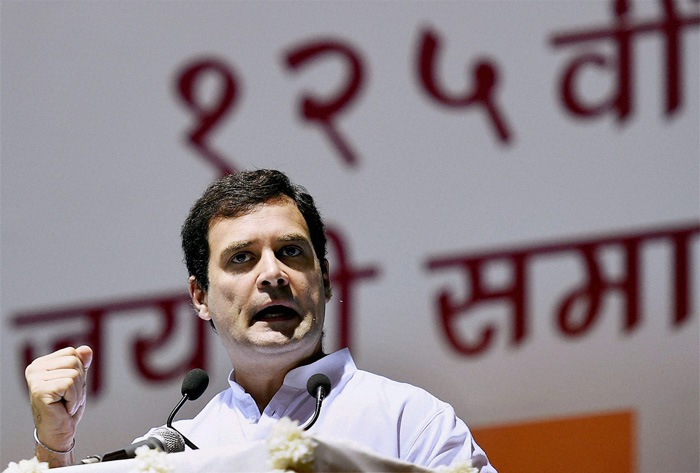Stay updated with the latest - Click here to follow us on Instagram
Delhi polls: Rahul joins queue at jhuggi-jhopri, says Cong is a ‘party of the poor’
Rahul's heavy pitch to the poor echoes Modi; bijli-paani at ‘lowest rate’.
 Rahul Gandhi.
Rahul Gandhi.
Delhi’s poor found another high-profile champion on Tuesday when Congress vice-president Rahul Gandhi arrived in South Delhi’s poor quarters and declared the party as the “party of the poor”. Prime Minister Narendra Modi had used the word “gareeb” more than 30 times in his Ramlila Maidan speech on January 10.
Looking to consolidate the support of Delhi’s urban poor — who form the AAP’s largest electorate — Rahul claimed that development under the Modi-led BJP government sought to favour “three or four industrialists”, while the poor and the needy were neglected. “Congress is a party for poor people. We will show them how to dream,” he said.
Rahul said the party was fighting the February 7 Assembly elections on three key issues — “provision of electricity and water at the lowest possible rate, regularisation of temporary and contractual employees and extend right to shelter to the poor on the lines of MNREGA and RTI”.
Rahul’s first rally began strategically at the Transit Camp in Kalkaji. Once a Congress bastion, Kalkaji has one of the largest concentrations of slum clusters and jhuggi-jhopri (JJ) colonies.
“The Congress government began the first project of in-situ construction of flats to rehabilitate those living in JJ clusters. The party has always been with those living in such colonies,” Ajay Maken, the party’s campaign committee chief and candidate from Sadar Bazaar, said.
Travelling in an open vehicle, Rahul passed through slum clusters near Kalkaji Extension and Govindpuri. He was accompanied by Maken, Delhi Congress chief Arvinder Singh Lovely, local candidate Subhash Chopra and Greater Kailash candidate Sharmishta Mukherjee.
Though many in the party admit that the AAP had made massive inroads into the Congress’s vote base in JJ clusters, Rahul remained dismissive of the party. Instead, he attacked the BJP-led government at the Centre.
“The NDA has been in power at the Centre since May but the PM is busy with personal PR (public relations). Not a single concrete thing has been done. The public is asking when the talks will get over and real work begin.”
Senior leaders of the party, however, admitted that AAP’s growing support in JJ clusters and unauthorised colonies was a worrying trend for the Congress. In the Kalkaji Assembly segment, for example, three-time Congress MLA Subhash Chopra was reduced to the third place in the December 2013 elections. The Congress received only 28 per cent of the votes polled and, though the BJP won the seat, many in the party credited the defeat to the 31 per cent voteshare received by the AAP.
“AAP was a debutant party but it successfully galvanised the minorities, the poor and those living in JJ clusters. Only the loyal Congress supporters voted for us and we were defeated,” a senior Congress leader said.
Warm people, cold calculations
 At Rahul Gandhi’s roadshow in Govindpuri on Tuesday.
At Rahul Gandhi’s roadshow in Govindpuri on Tuesday.
As Rahul Gandhi’s motorcade moved through the narrow lanes of Kalkaji’s unauthorised colonies, it was hard to imagine that this was the same party that is fighting to retain its relevance in Delhi. Standing atop an open truck, the Congress vice-president waved at the thousands of curious onlookers and supporters lining the streets and leaning from balconies.
The Rahul roadshow was almost a throwback to its days of glory. Party supporters walked at least a hundred feet ahead from the Gandhi scion, announcing his arrival. A troupe of drummers followed and after two vehicles brimming with security personnel, Rahul waved from a truck.
Three hours later, the Congress were quick to call the show a success. “Thousands came to the rally. This is an indication that people still want the Congress to govern the capital,” a senior leader said.
Whether this will translate into votes is what worries the party. Several spectators admitted that they had come to catch a glimpse of the Gandhi scion and perhaps even photograph him. “For decades we have not seen a big leader here. Rahul Gandhi is on TV every other day so we came to see him,” Madan, a rickshaw-puller, said. Asked if he would vote for the Congress, he said, “I haven’t decided yet. Last time I voted for Arvind Kejriwal.”
Several residents and shop owners at this JJ cluster admitted to voting for the AAP in 2013. Some said they would do so again.
But Congress leaders said the Kalkaji Assembly, in many ways, epitomised the party’s fortunes in Delhi. The party hoped that support would continue after the foundation stone was laid in 2013 for one of the first in-situ development sites for slum clusters, set to rehabilitate 8,000 people. But months later, it lost the segment.
The procession began metres away from the in-situ housing project. Auto-rickshaws with loudspeakers competed with supporters to remind those who had come to see Rahul, “The Congress that started this. It is the Congress that cares.”
Half way into his roadshow, Rahul reached out into the crowd, and pulled a young boy into the truck. A Congress scarf was wrapped around the boy. He repeatedly reached onto the crowds to shake hands with supporters, often letting them take a quick photograph. “Not many other leaders interact with the masses at such close quarters. Such gestures work to retain the votes of people here,” a senior leader said.







